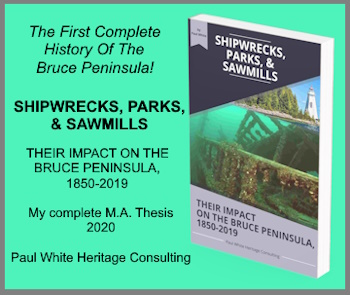Sailing Story:
The Voyage of the Prince Alfred
This is a sailing story that for me is prominent in the history of the Bruce Peninsula which is richly endowed with the tales of hardy pioneers battling the elements to survive and sustain an existence from an environment which was not always kind. I hope that you enjoy this tale of enterprise, energy and bravery.
Sailing Story: Ship Locked in the Ice
Because development of this region is indelibly linked to the waters which surround it, it is not unusual that some of the most heroic tales come from confrontations between the men and vessels which plied the coastal waters of the Bruce and the unpredictable elements which they faced.
In the winter of 1880, one such encounter occurred when the steamer Prince Alfred remained frozen in Tobermory harbour for four weeks.
During that time period, using two teams and as many as 20 workers hired from the fishing village of Tobermory,
Captain Andrew Port was able to harvest 500 tons of pure ice, some of which he hoped to ship to the American mid-west.
On April 4, 1880, the Prince Alfred was able to free itself from Tobermory harbour and travel to Manitoulin Island.
But the adventure of the Prince Alfred was not over. In fact, the worst of our sailing story was yet to come.
"Free At Last", But More To Come
On April 5, 1880, she left Manitoulin for Wiarton. At first, it looked to Captain Port that the trip home would be an easy sail. However, off Cabot's Head, a large body of floating ice was encountered.
Still, the Prince Alfred sailed on without much trouble until they were opposite Lion's Head harbour. Here, the little steamer became completely wedged in by the ice pack. In attempting to force her way through the ice, the ship's rudder gave way and the crew was powerless to free their vessel from the ice.
The Prince Alfred drifted helplessly with the ice until April 14, 1880. With only a half a day's fuel left, the ship's fires were put out to economize on fuel so that it would be available when the conditions arose that the steamer could break free from its icy prison.
For 10 days, the situation for the Prince Alfred was perilous. It looked like our sailing story was about to have a tragic end.
Without steam or rudder, the vessel was driven 40 miles towards the north shore of Georgian Bay. But the same elements which had imprisoned her also protected her.
When a terrific north-easterly gale arose, the ice surrounding the Prince Alfred shielded her from the raging storm's fury, all the while pushing her back on course and under the shelter of Hay Island at the mouth and Colpoy's Bay.
The warmth and shelter of their homes in Wiarton was so close for the crew but still unattainable.
Once again, the Prince Alfred became trapped in ice. This time between White Cloud Island and the mainland.
Captain Port walked across the ice to Big Bay where he telegraphed his family to tell them that everyone was safe. Then he returned over the ice to the Prince Alfred.
On Wednesday, the ice carried the Prince Alfred into Colpoy's Bay. Having exhausted her fuel and without proper steering capabilities, Captain Port made a landing where a fresh supply of fuel was taken on and a makeshift steering apparatus was improvised.
The Wiarton Echo reported on April 16, 188(), that with persistent effort, the gallant little craft made it into Wiarton at eight o'clock on Thursday morning, having made "one of the most remarkable and perilous trips in the annals of Georgian Bay navigation."
Throughout the entire odyssey, Captain Port and his son where the only ones on board capable of managing the steamer in these conditions.
However, while they were trapped in the ice, they kept no watch and they regularly turned in at night. But once the ship was too close to shore to be safe, the Prince Alfred was manned 24 hours a day by the father and son crew.
The Prince Alfred was built in Sarnia in 1859 and was used as a gunboat in Georgian Bay during the 1870s. Captain Andrew Port purchased the vessel for use as a trading vessel servicing Owen Sound, Wiarton, Tobermory, Manitoulin Island, and other smaller ports on the eastern shore of the Bruce Peninsula.
Sailing Story Comes to a Tragic End
Captain Port would have another encounter with the elements which so affected navigation on Georgian Bay.
In 1880, perhaps with the incident which occurred in the spring and winter of that year with the Prince Alfred in mind, he purchased a larger vessel, the Jane Miller.
With the Jane Miller, he plied the route he had so often taken on board the Prince Alfred.
However, in November 1881, tragedy struck. Captain Andrew Port and all on board perished as the Jane Miller went down off Wiarton.
2017: Our Sailing Story Continues
In 2017, divers searching the waters of Colpoys Bay found a shipwreck sitting on the bottom of the bay. After years of searching for the Jane Miller, it is believed that Captain Port and his vessel have been found.
See What This Vessel Looks Like Now After 136 Years In Waters Near Wiarton, Ontario
Watch the video below.
Georgian Bay Shipping
List of Lighthouses on the Great Lakes: If you have names and/or pictures of Great Lakes Lighthouses please submit them along with details of their location.
Georgian Bay Ships: A List of all the ships that sailed on Georgian Bay until the 1960s. This list is not complete. If you know of a ship that sailed the waters of Georgian Bay please contact me with information about that vessel, and, if you have a picture that I could post with it, that would be much appreciated.
1885: A Memorable Summer Job for Owen Sound teenage boys on the Great Lakes would have historic importance, not mention a possible exciting career opportunity.
Hindman Transportation Company was a well-known Great Lakes shipping company for many years. Here you will find pictures of many of the Hindman ships
Owen Sound Harbour – A Photographic History, by Robert A. Cotton is a book that interests my historiographical curiosity.
Commercial Great Lakes Fishing It is probably safe to suggest that the commercial fishing industry was an important part of the early growth of this region.
A Georgian Bay fishing vacation has long been a popular attraction in the Bruce Peninsula region. During fishing derbies, the regional waterways are dotted with fishing boats of all shapes and sizes.
The Georgian Bay Mackinaw, designed by William Watts of Collingwood is an example of a Georgian Bay innovator creating a vessel to service the needs local mariners.
Great Lakes fishing is an asset that is protected and developed, not only for its economic potential but also for those who just enjoy spending a day by the side of a river or in small fishing boats trying to catch “the big one”!
Great Lakes Fishing History is not without its controversy. The impact of the fishing industry was such that it played an important role in the development of communities along the Georgian Bay and Lake Huron shoreline.
Georgian Bay Travel Before the Winter Freeze-Up could be a dangerous time for mariners in the early years in this region.
A Harbinger of Spring on the Great Lakes in pioneer times, was the eagerly awaited news that a lighthouse had been lit and shipping traffic could begin sailing from port to port.
Lumber Hookers Lumber hookers and tugs were an important innovation to improve the transportation of lumber on Georgian Bay.
Mapmakers on Georgian Bay were also explorers. They mapped the Georgina Bay shoreline noting safe harbours, dangerous reefs and other guides for sailors and pioneer settlers looking for a place to call home.
Paddling Georgian Bay & Pondering: traversing parts of this great waterway in a canoe leads one to wonder about the ships of a bygone era battling the rough seas they encountered.
Parry Sound Shipping History: The Parry Sound area has always been connected to the southern regions of the Province of Ontario by a system of good roads. Or has it?
Parry Sound’s shipping history 2 is more than the tragic sinking of the Waubuno or the later catastrophe surrounding the sinking of the Asia.
Sailing Season Closing: A Frantic Time on Peninsula as ships raced from port to port delivering and picking up passengers and produce before the waterways froze.
Ship Captain Andrew Port was not only a dynamic and brave Georgian Bay mariner, he was a personal favourite historical character of mine.
Ships Stuck in Ice: The Oak Glen was icebound in 1996 but this sailing hazard has been impacting vessels on Georgian Bay since the beginning of time.
Lake Huron shipwrecks, the Hibou often occurred in the Georgian Bay region of that Great Lake due to the often violent waters that could strike unsuspecting vessels like the Hibou.
Shipwrecks: The "Asia" wrecked off the eastern coast of Georgian Bay taking all but two of the more than 100 passengers to a watery grave.
Masters, Mates, and Pilots Association created its first Canadian chapter on Georgian Bay, providing maritime safety education, and other seafaring issues to better inform its membership.
Pioneer Travel Aboard the Fly Tells the story of a sailing vessel as the tenuous link between survival and death in a pioneer settlement in the 1840's in Upper Canada.
Sailing Stories: the Captain Who Smelled his way into Port The Captain Who Smelled his Way into Port details how pioneer seamen on Georgian Bay safely sailed the rough waters without the aid of the modern technological tools so readily used by today's mariners.
Sailing Story: The Voyage of the Prince Alfred the incredible voyage of the Prince Alfred, fraught with danger for both vessel and the crew in the winter of 1880.
Shipbuilding As the southern Georgian Bay region became more populated shipping traffic increased to meet the needs of an expanding market place.
The Summer of 1844 was No Picnic for the early settlers in the pioneer area near what would become Owen Sound on Georgian Bay.
The CPR Grain Elevator Fire of 1911 spelled the end of Owen Sound's role as the eastern terminus of the CPR Great Lakes Fleet.
Georgian Bay shipping occurred long before the first Europeans paddled these waters. But the fur and timber trades opened Georgian Bay to shipping in a big way!





